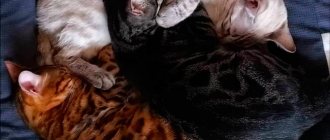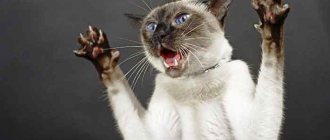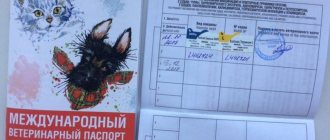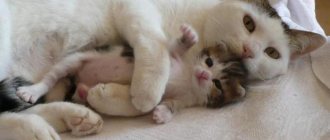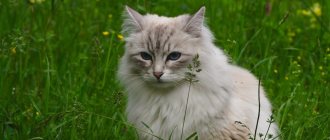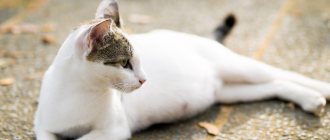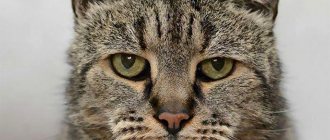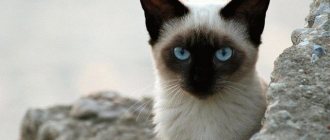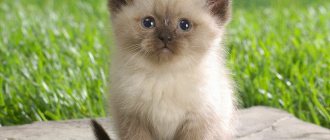Representatives of this breed are famous for their extraordinary, but at the same time very classic, exterior of a fluffy domestic Russian beauty. It is interesting to know how and where Siberian cats originated, what is unique and all the possible nuances of their appearance, what their disposition and health are like (see all photos of the Siberian cat).
Video
* We invite you to watch a video about the Siberian cat . In fact, in front of you is a playlist in which you can select and watch any of 20 videos about a given cat breed by simply clicking on the button in the upper right corner of the window. In addition, the material contains quite a lot of photos. By looking at them you can find out what a Siberian cat looks like.
In this article:
|
Rate the material!
[Total votes: 10 Average: 4.4]
The Siberian cat can be of almost any shade. These animals have a lively and inquisitive character, well adapted to cold areas. In addition, they are endowed with a heightened hunter’s instinct, which makes them especially useful for private homes: they will discourage rodents from settling even close to the house.
History of the breed
Siberian cats were first mentioned in the 16th century, but the large animal had a different name - Bukhara. By the way, this name of the breed is still preserved in the Volga region. Then there are records from the 18th century, which say that along the Silk Road, merchants brought a rather expensive, but very large and beautiful cat to the territory of the Russian state.
How did the red Siberian cat appear in Siberia? This is unknown. People from all over our beautiful planet came to explore this harsh region, and any of them could have brought an animal that eventually took root in such harsh conditions.
There is a version that the birthplace of the Siberian breed is Bukhara. But the Bukhara cats known today have an even more interesting coat, which they obtained as a result of crossing with a wild steppe and forest cat. But the fact that the Siberian red cat has wild ancestors is a fact. It was from their wild ancestors that the Siberians received their endurance, hunting skills, strength and some exterior features.
And yet, whatever one may say, the Siberian breed is indigenous. Breeders didn't even have to bother getting a certificate. It was only necessary to improve the gene pool, and crossing with very similar eastern breeds helped with this.
History of the origin of Siberian cats
The breed has a long history, but it is not entirely clear how and with whom it began. There are several versions. According to one version, it originated from Norwegian forest animals, which were brought to Siberia by settlers from the north of Russia in the 16th century. According to another, from Bukhara cats brought by traders from Central Asia.
Perhaps both versions are correct, and among the ancestors of the “Siberians” there are both Norwegian and Bukhara cats, as well as local wild species. Thanks to crossbreeding, cats brought from other places became very resistant to cold and improved hunting skills. Some researchers believe that the ancestors of Siberian cats included Pallas cats.
From Siberia, together with merchants, they spread throughout Russia and became the most characteristic “Russian” cat breed. There are many classical paintings of the 17th-19th centuries in which they can be seen. At the same time, Siberian cats were not a truly unified breed until their targeted breeding began in the 1980s.
Interesting fact: All large, fluffy and non-white cats were called Siberian, and they were selected based on these characteristics to develop the breed. The selected cats came from different regions, initially mainly Moscow and Leningrad, then individuals from Siberia and the Far East were also added to them.
They varied in size, color, coat texture, and so on, so it was not easy to develop a single breed. Finally, in 1991, its standard was registered by the World Cat Federation, and in the next few years it gained recognition in other countries.
If earlier Siberian cats were distributed only in the territory of the Russian Empire, then the USSR, then in recent decades they have been increasingly imported to Europe and even to other continents.
Breed recognition
Despite the fact that the Siberian red cat, a photo of which can be found in the article, became known since the 16th century, the breed was recognized only at the end of the 20th century. The first registered animal of this breed was a cat named Roman, and this event happened already in 1987.
Since the world recognized the Siberian cat, it has become one of the most popular and sought-after breeds. Siberian cats today are not valued as mousecatchers (as was the case before the breed was recognized), but are distributed all over the world as pets, and they certainly no longer need to worry about food.
Siberian cat - description of the breed
They are quite large - cats weigh 6-8 kilograms, and sometimes up to 12 kg, cats on average weigh a little less. They grow up to five years. The body is large, the muscles are well developed. In addition, they are fluffy, which makes them look even more impressive. In order to move quickly at such sizes, they have strong paws - their paws look powerful and wide.
They have similar features to Persian cats: a collar on the neck, “pants” on the hind legs. But the breeds are not related, and if a Siberian cat exhibits signs that are usually characteristic only of the Persian, then they are considered a defect. The fact is that sometimes these breeds are crossed to obtain new colors of Siberian cats.
Characteristics of the breed:
- The head is trapezoidal, large. The transition to the muzzle is smooth, it itself is graceful and expressive thanks to low cheekbones, full cheeks and a convex forehead;
- Ears, rounded at the end and slightly tilted forward, with characteristic tufts;
- The eyes are set wide and slightly oblique, oval and evenly colored. There are yellow, green or blue, there are many shades that are considered desirable;
- The limbs are medium-sized, thickened and muscular;
- Summer and winter coats differ significantly: in summer the coat is quite short, only the tail is fluffy, in winter it becomes much longer, it has a collar and so-called “panties” on the hind legs.
The disadvantages of the breed are:
- Too graceful constitution: fragility of the skeleton, elongation of the body, too long and/or thin limbs, neck. The Siberian cat must have an athletic, powerful body;
- Small eyes, as well as very round ones - they should be slightly elongated;
- Large or small ears;
- Non-shiny wool.
WHY CHOOSE US? WHY CHOOSE US?
Siberian kittens, buy a kitten, buy a Siberian kitten, buy in Moscow, cat shows, meow forum, Siberian forum, Siberian, Siberian cat forum, pedigree database of Siberian cats, Siberian forum, Ponomareva Svetlana, Bengal cats, Persian cats, Maine Coon, Somalia, Shustrova Inna, Abramova Olga, experts, pavilions, bulletin board, Avito, business, car, auto repair, spare parts, buy a car, sell a car, e-bay, ebay, aliexpress, buy an apartment, sell an apartment, school, university, diploma, recipes, veterinary clinic, veterinary passport, children, medicines, exhibitions, where to go on weekends, Russia, channel 1, NTV plus, NTV, Sergei Dorenko, says Moscow, radio, TV, music, download, animals, Drozdov, photo, cat, cat , maneki neko, feng shui, cinema, tom cruise, mission impossible, TV series, interns, chronicle, events, Yandex, metrica, topcat, tika, vtsf, iku, fife, mfa, farus, nursery, ukraine, heather line, onyx gloria , crown of Siberia, tavaloga, periwinkle, sybaris, valenvik, power line, Rossiti, Khokhloma, Siberian gem, Manchuri, Talan, legend of Siberia, Angara, Adagio, Akuna Matata, Khristina Moiseeva, news, food, scratching post, tray, filler, house for cats, veterinarian, Udimova Marina, Taiga Star, Zoofest, Grand Prix Royal Canin, Catsburg, CFA, Facebook, in contact, Odnoklassniki, Arbat24, Barvikha, Rublevka, luxury, BMW, Cadillac, trip, Bali, Emirates, Sheikh, oil , barrel, zhukovka, top manager, board of directors, Moscow city, Urgant, Siberian dumplings, sports, football, Olympics, Forbes, Cannes, Hollywood, president, State Duma, official, Moscow24, Ren TV, television, correspondent, animal photography , pet market, Avito, bulletin board, Anna Rudakova, elite club, red gate, red square, the Kremlin, Russia, felinology, genetics, seminars, cats-info, calendars with cats, maneki neko, Japan, China, Vietnam, Steve Jobs, telegram, Pavel Durov, Eurasia, Google, Instagram, keyboard, computer, mouse, rodents, guinea pig, African hedgehog, rats, travel, circumnavigation, yacht, sea, island, e-mail, server, pavpeds, fractalbio, zoogen, Zvenigorodka , Irina Inozemtseva, Sergey Burmistrov, Twitter, pet brand, photoshop, Paul Maas, animal-ID, microchipping, canvas, Miakoschka, Australia, America, visa, USA, Tom Cruise, Hollywood, Disney, cat world gallery
2202/5000
Sibirskiye kotyata, kupit' kotenka, kupit' sibirskogo kotenka, kupit' v Moskve, vystavki koshek, myau forum, forum sibiryak, sibiryak, forum sibirskikh koshek, baza rodoslovnykh sibirskikh koshek, forum sibiriada, ponomareva svetlana, bengal'skiye kosh ki, persidskiye koshki , meynkun, somali, shustrova inna, abramova ol'ga, eksperty, pavil'ony, doska ob"yavleniy, avito, biznes, avtomobil', remont avto, zapchasti, kupit' mashinu, prodat' mashinu, e-bay, yebey, aliekspress, kupit' kvartiru, prodat' kvartiru, shkola, vuz, diplom, retsepty, vetklinika, vetpasport, detki, lekarstva, vystavki, kuda poyti v vykhodnyye, rossiya, 1 channel, ntv plyus, ntv, sergey dorenko, govorit moskva, radio , tv, muzyka, skachat', zhivotnyye, drozdov, foto, kote, kotik, maneki neko, fen shuy, kino, tom kruz, missiya nevypolnima, serialy, interny, khronika, sobytiya, yandeks, metrika, topket, tika, vtsf, iku, fife, mfa, farus, pitomnik, ukraina, veresk layn, onikks gloriya, korona sibiri, tavaloga, barvinok, sibaris, valenvik, vlasta layn, rossiti, khokhloma, sibirskiy samotsvet, manchzhuri, talan, legenda sibiri, angara, adazhio, news , kadillak, putevka, bali, emiraty, sheykh, neft', barrel', zhukovka, top menedzher, sovet direktorov, moskva-siti, urgant, sibirskiye pel'meni, sport, futbol, olimpiada, forbs, kanny, gollivud, president, gosudarstvennaya duma, chinovnik, moskva24, ren tv, televideniye, korrespondent, s»yemka zhivotnykh, zoobazar, avito, doska ob»yavleniy, anna rudakova, elitar klub, krasnyye vorota, krasnaya ploshchad', kreml', rossiya, felinologiya, genetika, seminary, koshki-info, kalendariki s koshkami, maneki neko, yaponiya, kitay, v"yetnam, stiv dzhobs, telegramm, pavel durov, yevraziya, gugl, instagram, klaviatura, komp'yuter, myshka, gryzuny, morskaya svinka, afrikanskiy yezh , krysy, puteshestviya, krugosvetka, yakhta, more, ostrov, ye-mayl, server, pavpeds, fraktalbio, zoogen, zvenigorodka, inozemtseva irina, burmistrov sergey, twitter, zoo brend, fotoshop, pol' maas, animal-ID, chipirovaniye, kanva, Miakoschka | Siberian Cats Australia
Siberian kittens, buy a kitten, buy a Siberian kitten, buy in Moscow, cat shows, meow forum, forum Siberians, Siberians, forum Siberian cats, the pedigree of Siberian cats, forum sibiariada, ponomareva svetlana, Bengal cats, Persian cats, maine coon, Somali, Shustrova Inna, Abramova Olga, experts, pavilions, message board, avito, business, car, car repair, spare parts, buy a car, sell a car, e-bay, ebay, aliexpress, buy an apartment, sell an apartment, school, university, diploma, recipes, veterinarians, veterinary passport, children, medicine tva, exhibitions, where to go on weekends, russia, 1 channel, ntv plus, ntv, sergei dorenko, speaks moscow, radio, tv, music , download, animals, thrushes, photos, kote, kitty, neeko manikins, feng shui, movies, volume cruise, mission impossible, series, interns, chronicle, events, yandex, metric, topkat, tika, wff, iku, fife, mfa , farus, cattery, ukraine, veresk line, onyx gloria, crown of siberia, tavaloga, barvinok, sibaris, valenvic, vlasta line, rossity, khokhloma, Siberian samotzvet, manchzhuri, talent, siberia legend, angara, adagio, hakuna matata, moiseeva khristina, news, feed, scratching, tray, filler, house for cats, veterinarian, udmova marina, taiga old, zoofest, grandiose at royal cane, catsburg, cfa, facebook, in contact, classmates, arbat24, barvikha, ruble, lux, bmv, cadillac, tour, bali, emirates, sheikh, oil, barrel, beetle, top manager, board of directors, Moscow City, Urgant, Siberian dumplings, sports, football, olympiad, forbes, cannes, hollywood, president, state Duma, official, moscow24, tv, television, correspondent, shooting animals, zoobazar, avito, message board, anna rudakova, elite club, red gate, red square Russia, felinology, genetics, seminars, cat-info, calendars with cats, maneki neko, japan, china, vetnam, steve jobs, telegrams, pavel durov, eurasia, google, instagram, keyboard, computer, mouse, rodents, guinea pig, African hedgehog, rats, travels, round-the-world, yacht, sea, island, e-mail, server, pawpeds, fractalbio, zoogen, zvenigorodka, inozemtseva irina, sermey burmistra, twitter, zoo brand, photoshop, pol maass, animal -ID, chipping, canvas, Miakoschka, Australia, America, visa, usa, tom cruise , Hollywood, Disney
Popular colors of Siberian cats
There are a large number of different colors recognized by the breed standard.
Among them:
- Black brindle. It is characterized by black stripes, and between them the fur can be gray, brown or orange. Black paws and tassels, raccoon tail;
- Red. Closely related to black: the offspring of black cats are often red and vice versa. There are also red-black cats (this color is called tortoiseshell). It is noteworthy that in cats of this color you can often see dark orange eyes, which are not considered an undesirable sign in them, but in individuals of other colors they are considered;
- Striped. Notable for the stripes on the paws and tail, and the complete absence of stripes on the cat's body. It is well passed on from generation to generation, which is why it is widespread;
- Smoky. The smoke effect comes from the white undercoat, so it is much more visible when the animal is moving. It is best if there is no movement at all if there is no movement. The stronger the color contrast, the better the smoky color looks.
There are many other acceptable colors, only a few of them are listed above. It is worth noting the features associated with white. Complete white is acceptable, and white spots are not considered a fault on any other color - unlike spots of other colors.
That is, with a white color, the cat should not have spots; it is necessary that the color be uniform. Young pets often have spots that disappear over time.
There are also several colors that are considered undesirable. These are chocolate, cinnamon, burmese, light beige, lilac, fawn. Among cats with intense colors, those whose coat color is the brightest are valued first of all. With a lightened color, the opposite is true - the lighter and softer the shade, the better.
How to buy a Siberian ginger kitten
It is preferable to contact professional breeders and nurseries.
The price for a baby depends on a number of reasons: pedigree, color and other nuances. Prices for purebred Siberians start from 5,000 rubles (1,200 hryvnia) and can go up to 20,000 rubles (8,000 hryvnia).
Those who choose a Siberian baby from one or another breeder or nursery will not regret having such a wonderful friend.
Character and habits of Siberian cats
Siberian cats are smart, think quickly, and are endowed with a strong hunting instinct. At the same time, they become attached to the owner and members of his family, showing friendliness and sociability to a greater extent than representatives of many other breeds. It is believed that their character has quite a lot in common with that of a dog.
Thus, they treat strangers with suspicion, reminiscent of guard dogs. Of course, they won’t growl at strangers or bite them unless they show aggression themselves, but at first they will look at guests with wariness and will not want to be picked up.
Interesting fact: Siberian cats do not like noise, but they get along with children. Provided that they are not too small and do not squeeze them too much, much less pull their tail, such children can be scratched. Usually they don’t mind playing, but they don’t play around too much, they’re quite calm.
If the owner is not interested in her, the Siberian cat will not run around him and demand to play - she will go about her business or just sleep. Often at the same time he falls apart on his back and raises his paws up. Loves to bask in the sun in funny poses.
Sometimes it happens that the owner himself decides to cuddle her, but she is not in the mood: in this case, it is better to leave the cat alone, otherwise she may get angry. They don’t always get along with other pets: some easily accept new members into the family and even protect them from strangers, others hurt smaller cats and even small dogs.
In general, they often conflict with dogs: even if they are larger, Siberian cats often begin to bully them and try to show that they are the owners of the house. They tend to hunt various hamsters and rats and refuse to admit that these are pets and not prey that has sneaked into the house.
Summary about ginger Siberian cats
The broad Siberian soul lurks in the strong bodies of these magnificent animals. The friendly and sociable creature has retained many of the characteristics of its wild predecessors: a passion for hunting and natural vigilance and attentiveness.
Legends are made about the intellectual abilities of Siberian women. They do not need to be taught various tricks using training techniques, since these cats independently, looking closely at human behavior, figure out what is required of them.
Representatives of this breed are excellent companions and companions, capable of maintaining self-esteem. Although they love to run free, they are strongly attached to the hearth and home and are reminiscent of dogs. They have virtually no fear.
Things that frighten other cats only entertain the Siberian breed. These pets are taciturn and do not speak unless absolutely necessary. They are in excellent health and have no genetic diseases.
Interesting facts about Siberian cats
As natural hunters, Siberian cats love to watch the surroundings from some height, and even in an apartment they regularly climb onto cabinets, shelves, and window sills. If a cat has the opportunity to climb onto a chandelier, it will definitely try to do so, so make sure that the chandelier is either safe and secure, or that the cat does not have access to it.
Siberian cats understand intonation well and remember commands; for example, they can be trained to fetch small objects. But they are quite stubborn and will not always do this at the first call, like some dogs. To make it easier to train a cat, you need to turn the process into a game: reward it for its successes and not scold it for its lack.
Colorpoint Siberian cats were identified as an independent breed called Neva Masquerade.
The Siberian cat's coat is so long and dense that it protects it not only from the cold, but also from almost any rain, except the heaviest - the undercoat does not get wet, and the guard hair dries quickly.
Some Siberian cats produce much less of the Fel d1 protein that causes allergies in some people. Thanks to this, many allergy-prone people who cannot keep ordinary cats can easily tolerate living in the same house with Siberian cats.
Unfortunately, it is impossible to determine in advance whether this will be the case: the absence of an allergy to a kitten does not mean at all that after it grows up, everything will remain the same. Although, if there is no reaction to his parents, most likely there will be no reaction to him either.
What to look for when buying a Siberian cat?
When buying a Siberian cat, you need to pay attention first of all to its appearance and behavior. The kitten should not be lethargic, passive, aggressive, withdrawn, or cowardly. When choosing a high-class Siberian, it is recommended to seek the help of professionals who know the breed standard. The breeder needs to clarify information about the health of the selected animal and its parents, in particular, whether there are any hereditary diseases in the family, and if so, which ones; whether vaccination, sterilization or castration (for pet-class cats) has been carried out and other information. You should also inquire about the character traits of your future pet. It is equally important to ensure that the documents are properly prepared and authentic. For this purpose, it is recommended to first look at samples of filling out pedigrees on the clubs’ websites; you can also check the authenticity at the club that issued the document, or seek the help of the same specialist.
Video
Pros and cons of Siberian cats
Before deciding whether to get a cat of this breed, you need to carefully weigh its advantages and disadvantages in comparison with others.
To make this easier, we will give an approximate list of both - of course, for some one will turn out to be very important and the other quite insignificant, for someone the features that are not reflected at all below will seem important - but you can get a rough idea.
Pros:
- Friendly and energetic – the Siberian cat loves to play with people; when she is in a good mood, she is calm about being squeezed;
- Intelligence - it is quite easy to teach her the rules of behavior in the house, and she can even remember several commands;
- Beauty - they are fluffy and very beautiful, it’s not for nothing that in the West there are queues for every kitten;
- Health – they get sick quite rarely, especially if they are well maintained, and can live up to 15-20 years;
- Unobtrusiveness - if a Siberian cat sees that the owner has no time for her, she will not hang around, but will go about her business;
- The ability is almost everything that people have.
Minuses:
- The need for hair care. It will need to be combed regularly and thoroughly, otherwise hair will fly around the apartment, and the pet itself will lose a significant part of its external gloss;
- Need for walks - in a private home, a cat will often walk for most of the day, which can sometimes lead to torn ears and other injuries. In the apartment, she must be taken out for a walk at least for a couple of hours;
- Aggression towards other pets - such a cat will most likely not give life to rodents and other small pets. It can easily not get along with large dogs and other cats.
Description of the Siberian red cat
The breed is spectacular due to its incredibly powerful physique. The cat is muscular, has powerful bones, and the fluffy coat gives even more power to the already not small animal. Despite their enormous size, Siberians are very kind.
Many cat lovers who are allergic to animals may be put off by the presence of a large amount of fur. But, despite the length and thickness of their fur coat, Siberian cats are completely hypoallergenic and do not pose a threat to human health. Grooming is also not particularly difficult, but required.
Breeding Siberian cats
Cats grow rather slowly, up to five years, but enter reproductive age early, starting at 5-6 months. This is due to the fact that the Siberian cat breed also originated from wild cats, which begin to reproduce early due to the numerous dangers that threaten them in nature.
It is still better to carry out the first mating later - when both the male and female are at least 10 months old. It is imperative that they receive all the necessary vaccinations, and a month before mating, a course of treatment for parasites is carried out. To get purebred and licensed kittens, you need to show the cat to experts who will evaluate her and indicate which cat she should choose.
The mating itself must be carried out in agreement with the club; usually the cat is brought to the cat and left for 1.5 days. Although mating does not always go smoothly, during the first mating the cat may not let the cat near her for some time - up to two days.
From the beginning of pregnancy, the cat may become drowsy and her appetite will increase. You need to immediately increase the amount of calcium in the diet, otherwise there is a risk of tooth loss, and the kittens themselves may be born with weak bones.
Pregnancy lasts 9-10 weeks. By the end of it, you need to prepare a place for childbirth: it should be warm, shaded and calm. You can take a large cardboard box - for example, from a TV, and cut out one of the walls. At the same time, you need to leave a little bit underneath - so that the kittens cannot get out in the first days, but at the same time the cat can see them from the outside.
The cat owner himself needs to prepare, especially if it is the first birth: complications may arise, so you should always have the veterinarian’s number at hand, as well as a special first aid kit with scissors for cutting the umbilical cord, if necessary, disinfectant, diapers and other items needed during childbirth things.
The offspring are on average more numerous than those of other cats - most often 5-6 kittens are born. However, sometimes only one kitten can be born, but sometimes ten appear at once. Reproductive age lasts up to 10-12 years, but the best time is from 1.5 to 6 years - at this time the mortality rate of kittens is the lowest, they almost always appear healthy and without abnormalities.
Caring for Siberian cats
They prefer to live in country houses because they love to walk and hunt freely, which they cannot do in the city. Rodents are exterminated very effectively, surpassing other breeds in this - that is why they have become so widespread.
But you can also keep them in a city apartment, only in this case you will have to walk them more often. Siberian cats are not nearly as demanding in this regard as dogs, but at least once a week it is worth going outside with them, and for a long time. It is better to take walks every two or three days, because if the cat does not burn off its energy during a walk, it will do so in the apartment.
Then the furniture will be in trouble; it may even show aggression towards the owner. Since cases vary, and even if you usually have time for walks, sometimes you have to skip them, it is useful to arrange a special corner for games so that the cat does not destroy the interior throughout the apartment in such cases.
Interesting fact: Another useful acquisition can be a comfortable bed. The cat itself can just as easily settle on your furniture and will not complain, but then you will have to clean it of fur. You need to carefully care for the fur, especially during shedding: you should comb your pet two, or preferably three, times a week.
The rest of the time, it is enough to do this procedure once a week. Use a special long-tooth comb for her to reduce hair in the house, and don’t forget about the slicker brush. You should start brushing the kitten already, then the pet will get used to it and will not be overly nervous and struggle.
You shouldn’t bathe your pet too often; he will successfully keep his fur clean. The procedure is carried out once every three months, but thoroughly - you need to wash the cat with a special shampoo. While most ordinary cats hate bathing and resist the procedure in every possible way, Siberian cats are calm.
Of course, there are exceptions, but if you accustom your pet to bathing from his youth, rewarding him with something after each, then over time he will get used to it and will calmly allow himself to be washed - and in nature he can even get into the water himself, trying to catch fish .
You need to bathe your cat in the bathtub, with water at a temperature slightly less than 40 °C. Be sure to dry it thoroughly, wrap it in a towel and take care that it is not exposed to a draft while it is drying: long-haired cats are very prone to catching colds when their fur gets wet, and as long as it is dry, they don’t even mind frost.
Instead of cutting nails, it is better to buy a scratching post, and keep in mind: if you do not do this, your pet will sharpen its claws on furniture, walls or other objects that it finds most convenient for this. Even regular haircuts won't help. Your pet's ears need to be cleaned every week.
Diet of Siberian cats
They have an excellent appetite, and they are not inclined to pick at their food. You can feed them natural food or special food. In the second case, be sure to alternate between dry food and canned food. But natural products are still preferable.
If you select a menu from them, it may include:
- Meat;
- Bird;
- By-products;
- Sea fish;
- Dairy products;
- Eggs;
- Porridge.
Meat is given raw, scalded or boiled, but fish and offal are exclusively boiled. Eggs and dairy products should be given at least once a week. Goat's milk is preferable; cow's milk should not be used. Pregnant and lactating cats are given cream with no more than 10% fat content.
You should not pamper your pet too much: it is advisable that he does not refuse to eat porridge, primarily buckwheat, rice and rolled oats. But occasionally you can give him treats, for example, shrimp - many Siberian cats simply adore them.
The natural menu should be balanced by adding vitamins and minerals - it is best to consult a veterinarian about this. Considering what products you give to your pet, he will recommend the most useful supplements.
It is important not to overfeed your pet: if they like the food, they will eat everything you give, even if it is more than they need, and then they may also ask for more. There is no point in reacting to this if you know that the cat has received its calorie quota. Even seemingly small indulgences, if done regularly, can lead to your pet gaining excess weight.
This will not add health or longevity to him at all, so it is best to accustom him to discipline. After all, if you do not indulge him, over time he will stop begging for food outside of the schedule.
Diseases and health problems
Siberian cats have good health, but they are still not immune from diseases.
Among the most common problems are:
- Allergies;
- Diseases of the gastrointestinal tract;
- Diseases of the heart and blood vessels;
- Kidney failure;
Allergies can occur to pollen or dust, or in some cases to food. It is worth contacting a veterinarian and, if possible, eliminating the cause of the allergy. Changing your diet usually helps.
Problems with the digestive or cardiovascular system arise primarily due to poor nutrition or low physical activity of the animal. Even if there is nothing wrong with this, they can still appear in older cats. Their occurrence is indicated by the slowness of the pet; he may begin to cough and shortness of breath.
Siberian cats are susceptible to periodontal disease, which leads to tooth extraction. There are also individuals who inherit a predisposition to cancer - primarily white cats.
Urolithiasis, which can lead to kidney failure, and the accumulation of hair in the intestines are dangerous for representatives of the breed. Usually the animal regurgitates the fur, but some may still remain in the body. If your cat has problems with this, vegetable oil (except castor oil) will help. A kitten should be given a teaspoon, an adult cat a tablespoon.
Important fact: To reduce the risk of diseases, it is worth vaccinating your pet on time and not forgetting about parasite prevention: cats roaming freely around the area inevitably become infected with them, and many diseases arise from them.
